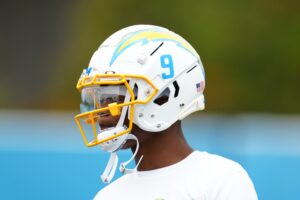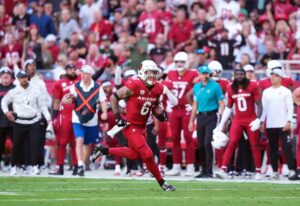On January 16th, 2019 the Denver Broncos tabbed Rich Scangarello to become their new offensive coordinator, his first time in the role in his two years in the league at that point. In spite of the anemic nature of the passing offense with former Super Bowl MVP Joe Flacco under center, Scangarello consistently illustrated his inexperience during the 2019 season, often calling unsuitable plays in various situations and regularly straying from the rushing attack in his first and only season with Denver. Unsurprisingly, even though head coach Vic Fangio touted the importance of continuity during the season, Denver fired Scangarello on January 12th, 2020 – less than a year after being hired – for his inability to utilize his personnel to capitalize on their varying skillsets. Only two days following Scangarello’s departure, the team came to terms with Pat Shurmur; a coach of differing roles throughout his 21 years in the NFL, including no less than ten years of calling plays, offering a stark contrast to the sophomoric Scangarello.
Can Pat Shurmur Offer Offensive Stability?
Ever since Mike Shanahan’s offenses consistently finished in the upper echelon of the league, the Broncos offensive management has fluctuated from one of the worst in the league to the greatest of all-time and back again, leaving the team in the throes of ebbs and flows. When the offense was persistently impotent under Mike McCoy, Bill Musgrave, and Rich Scangarello, the offensive coaching has lacked consistency, especially as it pertained to the latter.
While it certainly is easy to assume the team will be better off with a more experienced play-caller at the helm, the offensive staff is still relatively unproven working together with these players, a sentiment deepened by the sheer youth and inexperience of the players themselves. Last year, rookie play-caller Rich Scangarello struggled mightily to consistently employ the run game and neglected the efficiency of play-action passing to bridge the gap between the under utilized rushing offense and the stagnant, anemic passing offense under quarterbacks Joe Flacco and Brandon Allen. Despite the personnel suggesting a more vertically-based passing attack with complementary football at running back, Scangarello opted to deploy Royce Freeman as the pass-catching back and Phillip Lindsay sparingly.
Lindsay’s performance mandated considerably more snaps throughout the season. However, thanks to Flacco’s ineffectual performances the offense as a whole was worse in many ways than it had been under Bill Musgrave (who coached the 24th and 27th overall offenses in his time in Denver).
While Scangarello proved himself undeserving of a second season with the team, Pat Shurmur is a proven play-caller. He was able to derive an incredibly unexpected and impressive rookie campaign from Eli Manning’s heir apparent, Daniel Jones— a quarterback many considered in need of extensive coaching and unfit for his draft position. Shurmur’s experiences with the New York Giants in his two years as head coach would result in him meeting his average offensive ranking from the past decade.
Dissecting the Pat Shurmur Offense
Some of the more recognizable flavors of Shurmur’s offense with the New York Giants in 2019 were the sheer volume of vertical passing opportunities and running plays designed to maximize the varied rushing skills in the room. He did not quite utilize Saquon Barkley in the passing game to the best of his abilities. However, in Denver there is a need to get both Melvin Gordon III and Phillip Lindsay their respective snaps. As such, it would not be surprising to see Pat Shurmur improve upon his mistakes from 2019 in this regard.
Keep an eye on a few specific aspects of Shurmur’s scheme, such as the snap differential between shotgun and under center and the disparity between snaps out of a huddle versus snaps in the no-huddle offense. The 2020 Denver Broncos offense is young, speedy, and athletic, making the no-huddle approach a great way to keep opposing defenses on their heels; especially since they play at altitude for half of the season. In 2019, Denver ran 45 plays in a no-huddle offense, while Shurmur’s Giants ran 90— literally double. In the same season, Scangarello lined his quarterbacks up in shotgun just shy of 500 snaps, whereas Pat Shurmur lined up in shotgun over 720 snaps, which boils down to 72 percent of snaps for the Giants in comparison to 52 percent of Denver’s snaps.
Drew Lock’s stint under center in the final five games of the season may skew the numbers, as he only averaged one attempted pass in the no-huddle offense per game played. That said, 114 of Lock’s 156 rookie passing attempts came out of a shotgun, a 73 percent clip, which surpasses even Shurmur’s year-long distribution for his quarterbacks in the Big Apple.
These numbers lend to the play-action percentages found in Shurmur’s offense versus Scangarello’s. Between Daniel Jones and Eli Manning’s combined 606 passing attempts, a total of 109 were play-action passes, totaling 18 percent of their overall passing attempts. On the other hand, Rich Scangarello’s offense between Joe Flacco and Drew Lock (Brandon Allen’s limited volume of snaps skew the numbers) saw a mere 69 play-action passing attempts out of 418 total passing attempts, yielding a 16.5 percent distribution. Shurmur’s 18 percent figure in New York last year should prove conservative when taking into account the talented runners in the Denver backfield and the electric wide receiver corps. This is especially true considering how Jones’s completion percentage jumped 4.13 percent when attempting a play-action pass. This leap is a noticeably higher differential than what Drew Lock enjoyed under Scangarello.
Most excitingly, it seems inevitable the Broncos will see a significant increase in passing attempts beyond 20 yards. Joe Flacco, who started the majority of games for Denver in 2019, attempted less than half of the number of attempts over 20 yards that Daniel Jones alone had last year. Jones’s completion percentage may have been 8.3 percent lower on these throws, but Flacco’s numbers, when viewed in context, are far worse than Jones’s. Lock’s arm, which is stronger than Jones’ and arguably stronger than Flacco’s, supports the notion of a greater volume of deep passing attempts in 2020. The arrival of Denver’s new skill position players (who are faster, more experienced, and more dynamic than the weapons Lock and Jones played with) should serve to solidify a more vertically-based offensive approach. Some considered the team’s unwillingness to throw the ball deep the result of a stark lack of breakaway speed at the wide receiver position, but Scangarello’s design and questionable calling of plays must shoulder at least a portion of the burden of this one inefficiency of many in the 2019 Broncos offense.
But Pat Shurmur is not alone on the offensive coaching staff.
Other Offensive Operators
Perhaps best known for his outstanding work with Cam Newton when the quarterback was a rookie nearly a decade ago, coach Mike Shula took a demotion from the most prestigious post in his NFL coaching career, the Giants offensive coordinator, to become Denver’s quarterbacks coach in 2020. This suggests a comfortability with Shurmur and his scheme, as well as a specific attraction to the opportunity to work with and mold a face-of-the-franchise out of the undeniable potential in Drew Lock. Lock’s 64.1 percent completion percentage as a pro is superior to any completion percentage he accrued in his college career. Shula has also helped such quarterbacks as David Garrard and Jay Fiedler deliver some of their better seasons as pros.
But will Shurmur and Shula’s arrival in Denver yield improvement and the consistency unseen in the offense since Peyton Manning and Mike Shanahan? History suggests it will, but it is critical to note they are not the only coaches who would play a role in this.
Mike Munchak’s second season with the Broncos should generate tangible dividends, much like that which was seen in the play of Connor McGovern in 2019 and the phenomenal rookie year of Dalton Risner. Widely considered one of the better offensive line minds in coaching circles within the NFL, Munchak brings to the table the talent, skill, and coaching experience that earned him candidacy for Denver’s head coach position during the coaching search in the 2018 off-season. Munchak’s continued tenure in Denver is the key coaching carry-over to keep an eye on, as only three starters on the offensive line will return in 2020. This is including Ja’Wuan James, whose total snap count last year was a paltry 63 with injury marring his campaign, and Garett Bolles, whom most fans and pundits reasonably expect to see replaced sooner than later. After finding great success with the Pittsburgh Steelers offensive line, Munchak has helped Dalton Risner become the face of the offensive line in one season’s worth of play, all the while continuing to pull the best out of lesser-known names like Austin Schlottman and Jake Rodgers.
While the offensive tackle situation is precarious, if there is a single coach in the league capable of settling Ja’Wuan James into the right tackle slot, it’s Mike Munchak. He should enjoy success in coaching new acquisitions in the form of third-round rookie Lloyd Cushenberry III and versatile free agency addition Graham Glasgow. These new arrivals should compound with Lock’s athleticism, Munchak’s continued presence, and the shift to Shurmur’s scheme to significantly improve the offensive line’s effectiveness in 2020. For added context, the offensive line should enjoy the benefits of two elite running backs in Melvin Gordon and Phillip Lindsay softening the box, as well as arguably a top-three receiving corps in the league to keep the defense honest. If 2019 first-round tight end Noah Fant can improve his blocking capabilities under Munchak’s tutelage, it would not be surprising to see the blocking effectiveness of the team become the most improved aspect.
Conclusion
Outside of the Jake Plummer– and Peyton Manning-led teams, Denver’s offenses in the 21st century have, by and large, been mundane, often in the bottom half of the league when compared to their peers. While wasted offensive draft picks the likes of quarterback Paxton Lynch, wide receiver Carlos Henderson, running backs Montee Ball, Ronnie Hillman, and Devontae Booker, and offensive tackle Ty Sambrailo are at least partially responsible for this mediocrity, the inexperience and lack of schematic suitability of the various offensive coaching staffs are just as much, if not more, to blame. With consistency and veteran savvy now characterizing the vast majority of the offensive coaching staff in Denver, the high volume of talented new additions on the field should develop with haste.
Considering how difficult it has been for Denver to develop young offensive players, Broncos Country can only hope Pat Shurmur is the right man to pioneer the offense while Vic Fangio leads the defense. If Shurmur hopes to lead the Broncos to a top-five offense as he did with the Philadelphia Eagles in 2013 and 2014, he will have to learn from Rich Scangarello’s mistakes, not only his own. The personnel at his fingertips in Denver offer him the best opportunity to do so.
In that regard? There is no place like Denver.
Main Image:






